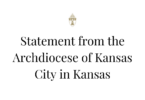by Joe Bollig
joe.bollig@theleaven.org
TOPEKA — When Father Bill Bruning and his parishioners were planning the new Mother Teresa of Calcutta Church here, they asked themselves: “WWMTB?”
That is, “What Would Mother Teresa Build?”
That question was answered on Dec. 22, when Archbishop Joseph F. Naumann blessed the newly constructed church and dedicated the altar.
Father Bruning and the parishioners believe they’ve built the kind of church Mother Teresa would applaud — something simple, elegant, utilitarian, and economical.
Given the blizzard-like conditions the day of the dedication, it was a good thing that the parish had not taken to heart the suggestion of Topeka native Father Bob Conroy, now provincial for the priests of Mother Teresa’s order, the Missionaries of Charity.
“Father Bob Conroy . . . came to our parish the first week we had Mass at Hayden High School,” said Father Bruning, and someone asked him, “What kind of materials should we use to honor Mother Teresa?”
Father Conroy’s response was quick, but joking. “Use cardboard and two-by-fours,” he said, “and give the [money saved] to the poor!”
They didn’t use cardboard. The essential values, however, that Mother Teresa espoused — simplicity, thrift, and most importantly, a commitment to the poor — were retained in the construction process, the building, and the dedication of the church named in her honor.
The building has a clean, ascetic look, with a steel frame roof, concrete masonry, and cast concrete walls. Parishioners made the lectern, altar, sanctuary crucifix and other liturgical furnishings. The second-hand pews came from St. Elizabeth Ann Seton Parish in Salina and a closed World War II-era military chapel at Forbes Field in Topeka. The Knights of Columbus collected, stored, and installed the pews themselves.
Even the reception following the dedication Mass was unpretentious: punch and homemade cookies.
The heavy snow put a damper on the anticipated turnout, so the overflow seating went unused, but the 600-seat sanctuary was full.
Archbishop Joseph F. Naumann, the main celebrant and homilist, noted that the dedication had originally been scheduled for Dec. 8. Father Bruning, however, had it rescheduled because of an ice storm.
In his homily, Archbishop Naumann congratulated parishioners and Father Bruning for building their parish so quickly, and for the way in which the church symbolized “things done in the right order.”
“It is important for us to build as worthy a home as possible for our eucharistic Lord,” he said. “It is not that it makes any difference to him what materials we use or how what one community builds might compare with another. What does matter are our desire and our sacrifice to give God the best.”
Father Bruning, Father Gabriel Acheampong, sacramental minister at Mother Teresa, and Father Jon Hullinger, pastor of Mater Dei Parish in Topeka, were concelebrants.
Its three-and-a-half years of being “homeless” while waiting for its church to be built, said Father Bruning, helped form the parish’s identity.
“Not having a building of our own has given us a better opportunity to see the church as a community of love, not a structure,” said Father Bruning. “Our identity is not based on a structure, but upon the living body of Christ.”
“That is one of our fears,” he said. “I’ve heard people say, ‘I hope we don’t lose this spirit now that we have a place to call home — that we still see our identity based, not on a building, but on the incredible people who’ve sacrificed to make this building possible.”
Above all, the identity of the parish is based on the vision of Mother Teresa and reflected in the parish’s mission statement: to be committed to serve the most vulnerable in the parish, the community, and the world.
From the outset, the parish decided to dedicate 10 percent of its Sunday collection to the poor. The resulting Mother Teresa Grants have supported Let’s Help and the Marian Clinic in Topeka and built an orphanage in the state of Guntur, India.
“People could look at us and say, ‘You have this huge debt, why are you giving money away?’” said Father Bruning. “Our belief is if we take care of the poor, God will bless us. So we want to take care of the local community and the world community — have a true sense of our Catholic identity.”
It was only natural, then, that the parish celebrated its new building by giving gifts of $2,500 each to Let’s Help and the Marian Clinic, as well as some additional funds to projects in India.
“For the dedication we were going to have fireworks,” said Father Bruning, “but we talked about that, and instead of blowing up $1,000, we decided to built three homes for the poor in India.”
In his closing remarks, Father Bruning recognized several parishioners who played leading roles.
Among those honored were Jack and Flora DeBacker, who donated a home for use as an office and chapel for daily Mass, and Duane and Sue Kramer, who provided a home for the pastor. Duane Kramer and his brother, Gary Kramer, were general contractors for the new rectory, located east of the church.
Father Bruning also recognized Dennis Haworth, Ray Stuke, Basil Kicks and Max Kennedy for building the altar, lectern, and other liturgical furniture. Richard Sherer and Ralph Gutierrez were honored for crafting the sanctuary crucifix.
“The building is eventually to be transformed into a gymnasium, and so architecturally, it’s a good-looking, solid building. But it’s not extremely flowery,” Father Bruning said later. “So the furnishings themselves have added to the beauty of the structure and have become a focal point for the Eucharist. . . . They bring a lot of warmth to the building.”






